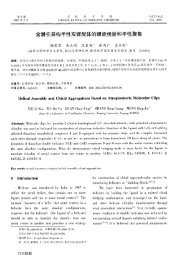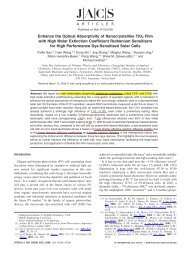Graphene Sheets from Graphitized Anthracite Coal: Preparation ...
Graphene Sheets from Graphitized Anthracite Coal: Preparation ...
Graphene Sheets from Graphitized Anthracite Coal: Preparation ...
You also want an ePaper? Increase the reach of your titles
YUMPU automatically turns print PDFs into web optimized ePapers that Google loves.
Energy & Fuels Article<br />
Figure 2. (a, b) Digital photos of samples before and after treatment with H 2 discharge plasma. SEM and TEM images of TX-NC-GS (c, d, e) and<br />
TX-C-GS (f, g, h) with different magnification.<br />
Figure 3. (a) FTIR spectra of coal-based graphite oxides and their chemically derived GS. (b) Nitrogen adsorption and desorption isotherms at 77 K<br />
of GS <strong>from</strong> H 2 discharge plasma (inset: pore-size distribution). (c) Raman spectra of coal-based graphite, GO, and GS.<br />
G = (0.3440 − d )/(0.3440 − 0.3354)<br />
002<br />
where d 002 is the interlayer spacing of (002) calculated <strong>from</strong><br />
XRD patterns. From the XRD patterns, it can be calculated that<br />
the graphitizing degree of TX-C-G (91.98%) is much higher<br />
than that of TX-NC-G (66.28%). It is well-known that the<br />
diffraction peaks of (100), (004), and (110) will appear when<br />
high graphitization degree was achieved, and these peaks can be<br />
observed in the XRD pattern of TX-C-G rather than TX-NC-G.<br />
Therefore, it can be concluded that the applied catalyst<br />
substantially promoted graphitization of the coal.<br />
After oxidation of the coal-based graphite, their sharp (002)<br />
peaks around 26.2° basically disappeared, while the as-prepared<br />
TX-NC-GO and TX-C-GO gave rise to (001) peaks located at<br />
11°, corresponding to an increasing interlayer spacing <strong>from</strong><br />
0.335 to 0.749 nm, indicating that the TX-NC-G and TX-C-G<br />
were efficiently oxidized and oxygen was bonded to their planar<br />
surface. After DBD plasma treatment, (001) peaks of TX-NC-<br />
GO and TX-C-GO disappeared almost completely to give rise<br />
to TX-NC-GS and TX-C-GS, respectively, without any distinct<br />
peaks in their XRD profiles.<br />
5188<br />
Figure 2a,b is the optical photos of coal-based graphite oxides<br />
(TX-NC-GO, TX-C-GO) and their corresponding resultant<br />
products (TX-NC-GS, TX-C-GS) after H 2 discharge plasma<br />
under the same experimental conditions. Obviously, the volume<br />
of TX-C-GS increased remarkably compared with its precursor<br />
TX-C-GO, while the volume change <strong>from</strong> TX-NC-GO to TX-<br />
NC-GS increased only slightly after the DBD plasma treatment.<br />
It can also be observed that TX-C-GS is bulky and fluffy in<br />
appearance while TX-NC-GS is relatively compacted. Taking<br />
into consideration the higher graphitization degree of TX-C-G<br />
compared with TX-NC-G, it can be concluded that the<br />
expansion level of graphite oxide has a close relationship with<br />
the graphitization degree of its precursor. In other words, the<br />
high graphitization degree is of great benefit to the intercalation<br />
of graphite by the oxygen-containing groups during oxidation.<br />
The oxygen intercalated into the interlayer spacing of graphite<br />
will be removed to form gases (H 2O and CO 2) during the<br />
discharge process, and the yielding pressure overcomes the van<br />
der Waals force between the layers, so that the oxides can be<br />
exfoliated immediately during DBD plasma process. For the<br />
low level graphitization carbon, the interaction hardly takes<br />
dx.doi.org/10.1021/ef300919d | Energy Fuels 2012, 26, 5186−5192

















